The Spektr-RG space observatory, onboard the Russian Proton-M carrier rocket, was successfully launched into orbit, Russia”s state space corporation Roscosmos said in a statement.
The spacecraft was launched from the Baikonur cosmodrome in Kazakhstan on Saturday, which was the second launch of this type of launch vehicle in 2019, Xinhua news agency quoted the statement as saying.
The orbital observatory, equipped with two unique X-ray mirror telescopes, has begun its 100-day flight to explore the universe in the X-ray electromagnetic radiation, it added.
Spektr-RG is a Russian project with German participation, the main goal of which is to build a map of the whole sky with the registration of about 100,000 largest clusters of galaxies and three million supermassive black holes, according to Roscosmos.
























